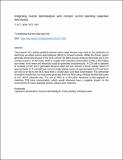| dc.description.abstract | The presence of a salinity gradient between saline water streams may result in the production of electricity via either reverse electrodialysis (RED) or forward osmosis. While the former system generates electricity because of the ionic current, the latter process produces electricity due to the osmotic pressure. In this study, RED is coupled with capacitive deionization (CDI) so that highly pure water, fresh water and electricity could be generated simultaneously. A CDI cell is operated at constant current, and it generated ultrapure water and two streams (a lower salinity stream of approximately 17.4 mol NaCl per m3 and a high salinity stream of approximately 512.8 mol NaCl per m3) to be fed to the RED stack from a 15,000 ppm CDI feed concentration. The performed simulation reveals that, the total power generated from the RED using infinitely divided electrodes is 0.57 W/m2 electrode area. The use of RED in a CDI plant introduces a new approach to minimize CDI brine concentration, which would otherwise have a negative impact on the environment if it were disposed directly without prior treatment. | en_US |

